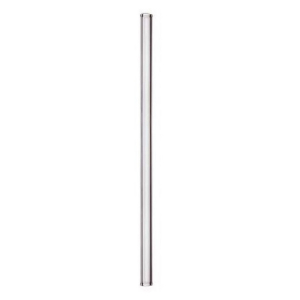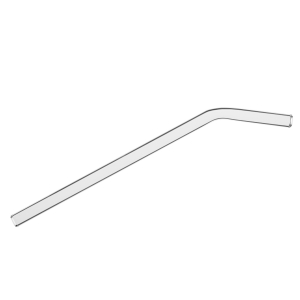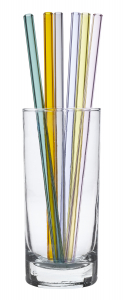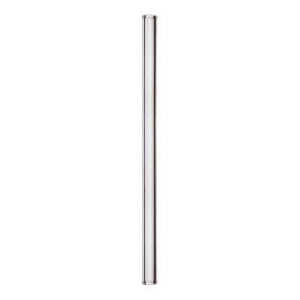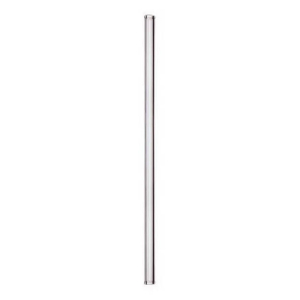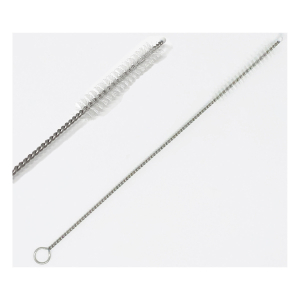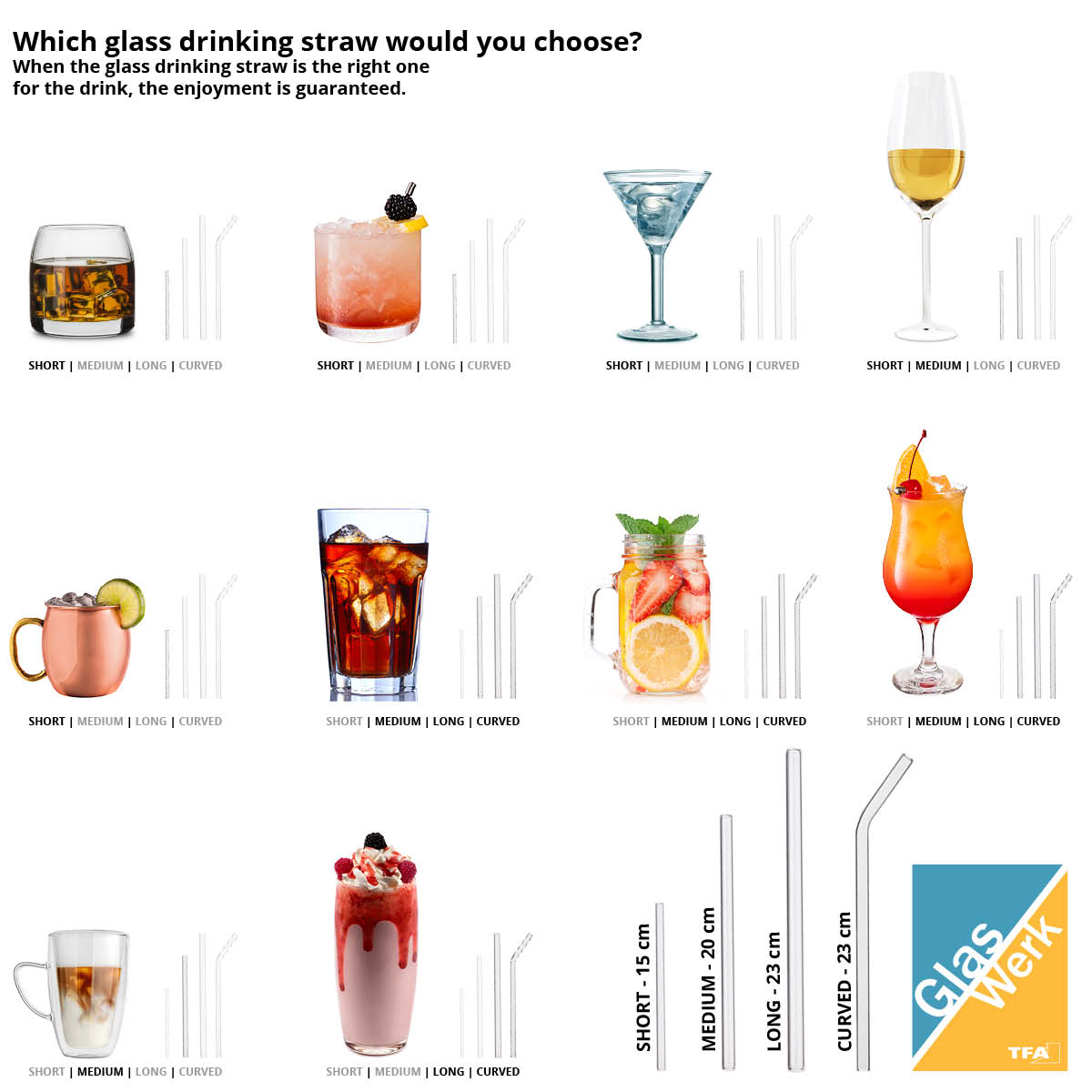Glass straws are a sustainable alternative to plastic straws and provide the right drinking sensation for many drinks and liquid foods. Due to its pure material, the taste is not adulterated. Thanks to their break resistance, glass drinking straws are just as suitable for dishwashers in private households as they are in hotels and restaurants.
Would you like to reduce plastic waste, have an eye-catcher for your cocktail party or hospitality industry or are looking for a unique gift? Glass straws are ideal drinking straws for your home , workplace as well as for restaurants and hotels. The different sizes of glass drinking straws make it suitable for every drink.
We have compiled a lot of information about glass straws for you here. In our sources of supply you can find out where you can buy glass drinking straws from TFA Dostmann. For TFA products, you can directly select a shop that stocks the product you are looking for by clicking on the “buy now” button on the product page.
Buy Glass Straws by TFA Dostmann
Glass drinking straws: reusable and environmentally friendly
Especially on warm days or when we are out and about, we like to reach for drinks that we enjoy with drinking straws. Until now, it was common to use plastic straws, but these will be banned from 2021. Discover a new kind of straw and continue to enjoy your favourite drink with a drinking straw in the future. Now in a refined and at the same time sustainable way with drinking straws made of glass.
Humans have been using drinking straws made of various materials for many thousands of years. So, alternatives to the plastic straw have always existed. Glass drinking straws are one of the most sustainable alternatives, because the glass we use is reusable and BPA-free. The GlasWerk drinking straws are also fully recyclable.
Glass drinking straws by TFA: GlasWerk
Under the brand GlasWerk we offer glass drinking straws as an alternative to plastic straws. The name GlasWerk stands for deliberately selected high-quality branded glass and is intended as a reminder of Wertheim as a glass producing city. At the same time, the name gives an indication of the production that happens in our own factory, at our company’s headquarters.
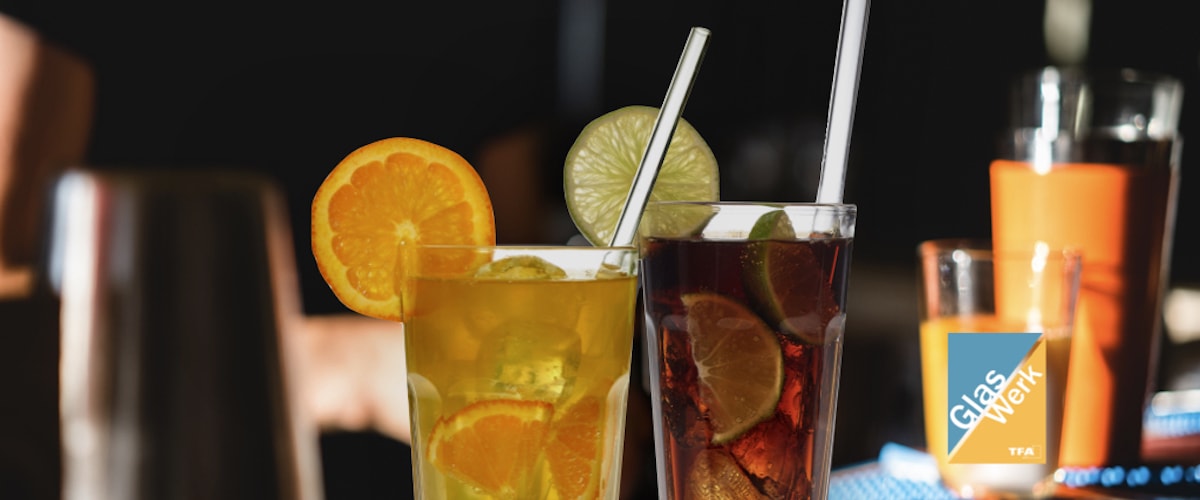
Glass drinking straws are reusable and environmentally friendly.
The glass drinking straws are handmade and produced directly in our factory using only high-quality SCHOTT® glass from Germany. This means that the glass drinking straws meet the highest hygiene standards, are reusable, recyclable and can even be cleaned in the dishwasher.
Glass drinking straws made of coloured glass
At TFA Dostmann you can also get glass straws made of coloured glass. The drinking straws are made of high-quality and sturdy glass. They are break-resistant, durable and dishwasher-safe.
Whether it’s at a party, a cocktail reception or in the catering industry, the tubes in different colours will always stand out and set the mood. The set contains drinking straws in the following colours: pink, orange, purple, yellow, green and dark grey. The different colours are a great way for guests to mark their own glass and avoid taking someone else’s drink.
What do we drink with glass straws?
Most of us like to set the table in a visually appealing way on special occasions such as birthdays, Christmas or a dinner party with friends. A glass drinking straw complements the table setting in a very special way. Timeless and elegant, the straws blend in with any colour scheme.
With a glass straw, you complete the table setting, elevate your drinks to a visual eye-catcher and demonstrate a flair for trends. Cocktails, smoothies, milkshakes and even coffee specialities are enjoyed best with a glass straw.
Another advantage of glass straws: the straw no longer bounces out of the glass when carbonated soft drinks are served, as is the case with plastic straws. The glass straw is heavy enough, but still feels light in the hand.
Which glass straw should I use for my drink?
Glass drinking straws come in a wide variety of sizes and shapes, depending on their intended use. The glass drinking straw GlasWerk SHORT /a> is suitable for many short drinks, aperitifs and smaller drinking vessels. The set contains either 10 pieces or 50 pieces.
With the Glaswerk MEDIUM drinking straw we have a standard size that is suitable for average glass sizes. Non-alcoholic drinks, such as juice spritzers and soft drinks, for coffee specialities, but also long drinks, the 20cm-long glass drinking straw fits glass and drinks. The “Medium” set is available with either 10 pieces or 50 pieces.
We enjoy a smoothie, milkshake or bubble tea from tall drinking vessels. For this, we recommend the GlasWerk LONG glass drinking straw. With a length of 23 cm, the glass drinking straw is the perfect companion even for jumbo cocktails. The set contains either 10 pieces or 32 pieces.
The curved drinking straw made of glass GlasWerk CURVED is ideal for jumbo cocktails, smoothies, iced tea, milkshakes or even bubble tea. It has a length of 23cm and is gently curved at the end, making it very comfortable to use. The set is available with 6 pieces.
The drinking straws made of coloured glass have a length of 21cm and are therefore suitable for many popular drinks such as Aperol Spritz, Hugo, Lillet Wild Berry, Gin Tonic, but also for smoothies, iced tea, latte macchiato and soft drinks in small bottles.have a length of 21cm and are therefore suitable for many popular drinks such as Aperol Spritz, Hugo, Lillet Wild Berry, Gin Tonic, but also for smoothies, iced tea, latte macchiato and soft drinks in small bottles..
As promotional items, the glass straws can be customised with laser engraving or printing. For example, companies can engrave their logo or an advertising message. Glass drinking straws are ideal handmade and sustainable promotional products:
Who are glass drinking straws suitable for?
Glass drinking straws are suitable for every age group and many areas of application, just like their plastic predecessors. They are perfect especially for users who are looking for a sustainable alternative, but at the same time want to enjoy the pure taste of the drink. Whether water, juices, cocktails, iced coffee or smoothies – discover the unadulterated taste with glass straws in transparent, fine colour.
Glass straws are also ideal for children, because they won’t chew on the solid material. Experience shows that small children tend to chew on soft and pliable materials. We recommend our drinking straws for children from the age of 3. Unlike plastic straws, our drinking straws are BPA-free and contain no harmful substances.
Restaurants and hotels benefit from the sustainable drinking straw. The glass drinking straws can be cleaned in industrial dishwashers without any problems.
Glass straws: a sustainable alternative
When we think of glass as a material, we usually associate it with purity, hygiene, recycling and timelessness. All these qualities make glass an ideal material when looking for plastic-free drinking straws.
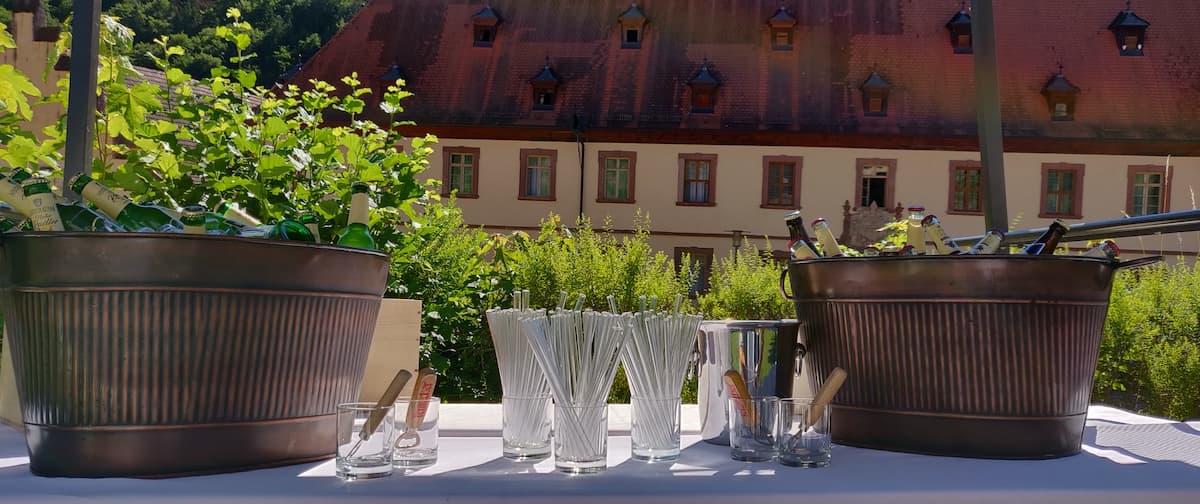
Glass drinking straws can be used like a normal drinking glass
But no glass is the same. Depending on the intended use, different substances are melted together during the production of glass. For example, there are a variety of types that have properties such as temperature resistance for the later end product or are used specifically for the production of optical glass.
Many types of glass, especially those with special properties, cannot be recycled. Borosilicate glass is used in laboratories because of its high resistance to heat. Borosilicate belongs to the group of special glasses and cannot be easily recycled in a waste glass recycling plant.
There are also different types of glass used for drinking straws. GlasWerk glass drinking straws are made from soda-lime glass, which is also known as normal glass. It is reusable and can be recycled an infinite number of times, which is why it is used for preserving jars, beverage bottles and drinking glasses.
During the production of GlasWerk glass drinking straws in Germany, we use a special process to relax the straws. In this way, the glass drinking straws from TFA are particularly break-resistant and durable.
Glass straws: stable and hygienic
With glass straws, you can enjoy your drinks in a stylishly and sustainably way. They are also extremely stable thanks to the special glass. The glass straws also meet the requirements in the kitchen or gastronomy in terms of safety, durability and service life. They are also easy to clean with a cleaning brush and therefore very hygienic.
Glass straws: cleaning and storage
But how do you clean glass straws? Washing by hand or in the dishwasher? Neither is a problem for glass straws. You can clean glass straws by hand or by machine. The glass drinking straws are break-resistant, so they can withstand both washing methods, just like any other drinking glass.
For dried-on residues inside the glass drinking straw, simply use the matching cleaning brush. With the brush, you can also remove stubborn dirt on the inside. Storing glass straws is also uncomplicated and they can be stored in the cutlery drawer as well as in the cupboard.
Nevertheless, glass can also break sometimes. Please do not use the product if it appears damaged. Glass can be 100 percent recycled if it is disposed of in an environmentally friendly way.
What materials are there for drinking straws?
Drinking straws are used in many everyday situations. That is certainly why consumption is so high: according to Statista, almost 24 billion plastic drinking straws are used per year in the 13 EU states.
The increasing pollution of the oceans has now also prompted the EU Parliament to make a decision that should put an end to drinking straws as we know them from 2021: The so-called plastic ban. At the same time as the EU decision, we are offering an alternative to the plastic drinking straw: our glass straws.
Today, we already know a variety of other materials for drinking straws. Be it paper, grass, noodle straws or bamboo, stainless steel or glass drinking straws. In practice, all variants show their advantages and disadvantages. Paper and grass in particular become soft when they are left in the drink for longer. Stainless steel is opaque, so you can’t be sure whether all the leftovers from the last smoothie have really been removed.
Glass drinking straws make the difference. The glass is transparent. You can see immediately if there is any dirt on the inside and can easily clean the straw. Glass drinking straws are just as easy to use as their plastic predecessor, but they come with many advantages:
- 100% reusable
- 100% dishwasher safe
- 100% tasteless
- 100% recyclable (GlasWerk glass straws)
Who invented the straw?
The oldest drinking aid still in existence dates from around 3,000 BC and was found in a Sumerian tomb. Images on clay jugs show people drinking beer with long pipes. It is assumed that the drinking straws served to filter out fermentation residues. Thus, the Sumerians may have been among the first to use a drinking aid.1
There is a similar reason for the use of bombilla, a metal drinking tube with a strainer, which is used when drinking Yearba Mate tea.
In the 19th century, it was fashionable to drink alcoholic mixed drinks with a stalk of ryegrass – the original form of the straw. The grassy aftertaste when drinking his favourite cocktail bothered the American cigarette holder manufacturer Marvin Chester Stone. He came up with the idea of making the straw out of paper. In January 1888, he applied for a patent for a paper drinking straw. He later developed the drinking aid further and coated it with wax to prevent the glue from dissolving.2
A little later in the 1930s, bendable straws were used in hospitals for the first time. These were invented by Joseph Friedman.3
The use of plastics was very high around the 1950s, so the industrial production of plastic drinking straws was a logical development. At that time, no one reckoned with the consequences for the environment.
Sources:
1 Andrack, M.: Schritt für Schritt: Wanderungen durch die Weltgeschichte. Munich/Berlin 2016.
2 Mariani, J. F.: Encyclopedia of American Food and Drink. London 2013.
3 Davidson, M.: A flexible mind in: American Heritage of Invention & Technology. 2005
